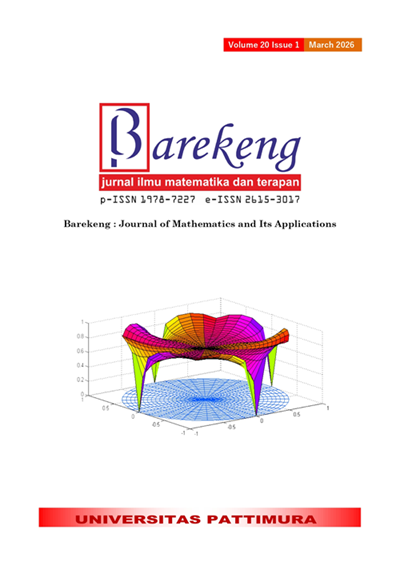INDOOR ACTIVITY RECOGNITION AND DEMENTIA RISK DETECTION USING Wi-Fi RECEIVED SIGNAL STRENGTH INDICATOR (RSSI) AND NAIVE BAYES CLASSIFICATION
Abstract
Increasing life expectancy has resulted in a growing elderly population, making neurodegenerative conditions such as dementia a major global health issue. One of the main behavioral symptoms of dementia is wandering, which is characterized by repetitive and purposeless movement. Activity Recognition (AR) technologies, particularly those based on Wireless Sensor Networks (WSN), have gained attention for monitoring human behavior. Among these, Wi-Fi-based tracking using the Received Signal Strength Indicator (RSSI) offers a promising method for indoor activity monitoring and localization. This study aims to monitor the daily routines of elderly individuals, classify their current activity patterns by comparing them with previously recorded behaviors, and track their locations using Wi-Fi RSSI. A Naïve Bayes algorithm is proposed for activity classification and location tracking, while a time-based behavior graph is used to detect potential wandering behavior, aiding in early dementia risk assessment. The research utilizes primary data, which were collected directly through experiments in a controlled indoor environment. The data source comprises RSSI signals obtained from elderly participants. A purposive sampling method was employed to select participants aged 60 years and above, who were physically capable of performing the required tasks. A total of 4150 RSSI data samples were collected and analyzed. The proposed Naïve Bayes model achieved a classification accuracy of 64.60% using cross-validation, with a minimum average localization error of 0.7 meters, demonstrating the potential of this approach for early detection of dementia-related wandering behavior.
Downloads
References
W. H. Organization, “DEMENTIA.” [Online]. Available: https://www.who.int/news-room/fact-sheets/detail/dementia
G. Cipriani, C. Lucetti, A. Nuti, and S. Danti, “WANDERING AND DEMENTIA,” Psychogeriatrics, vol. 14, no. 2, pp. 135–142, Jun. 2014, doi: https://doi.org/10.1111/psyg.12044
M. V. Devarajan, A. R. G. Yallamelli, R. K. M. K. Yalla, V. Mamidala, T. Ganesan, and A. Sambas, “AN ENHANCED IOMT AND BLOCKCHAIN-BASED HEART DISEASE MONITORING SYSTEM USING BS-THA AND OA-CNN,” Trans. Emerg. Telecommun. Technol., pp. 1–15, 2025. doi: https://doi.org/10.1002/ett.70055
I. Ahmad et al., “MULTI-FEATURE FUSION-BASED CONVOLUTIONAL NEURAL NETWORKS FOR EEG EPILEPTIC SEIZURE PREDICTION IN CONSUMER INTERNET OF THINGS,” IEEE Trans. Consum. Electron., vol. 70, no. 3, pp. 5631–5643, 2024. doi: https://doi.org/10.1109/TCE.2024.3363166
R. K. M. K. Yalla, V. Mamidala, A. R. G. Yallamelli, M. V. Devarajan, T. Ganesan, and A. Sambas, “INSIDER ATTACK MONITORING AND SECURED DATA TRANSFER USING KPCC AND BIO-ELSTM IN CLOUD COMPUTING,” Trans. Emerg. Telecommun. Technol., vol. 36, no. 4, pp. 1–14, Apr. 2025.,doi: https://doi.org/10.1002/ett.70095
A. Sambas, S. Vaidyanathan, and A. A. Aziz, “GUEST EDITORIAL - MACHINE LEARNING TECHNOLOGY FOR BIOMEDICAL SIGNAL PROCESSING,” IEEE J. Biomed. Health Informatics, vol. 28, no. 10, pp. 5661–5666, 2024, doi: https://doi.org/10.1109/JBHI.2024.3451828
S. S. Rautaray and A. Agrawal, “VISION BASED HAND GESTURE RECOGNITION FOR HUMAN COMPUTER INTERACTION : A SURVEY,” 2012, doi: https://doi.org/10.1007/s10462-012-9356-9
M. Tools, H. Yeo, and H. Lim, “HAND TRACKING AND GESTURE RECOGNITION SYSTEM FOR HUMAN-COMPUTER INTERACTION USING LOW-COST HARDWARE HAND TRACKING AND GESTURE RECOGNITION SYSTEM FOR HUMAN-COMPUTER INTERACTION USING LOW-COST HARDWARE,” Multimed. Tools Appl., no. April 2013, pp. 2687–2715, 2021, doi: https://doi.org/10.1007/s11042-013-1501-1
S. H. Ahmed and D. Kim, “NAMED DATA NETWORKING-BASED SMART HOME ✩,” ICT Express, vol. 2, no. 3, pp. 130–134, 2016, doi: https://doi.org/10.1016/j.icte.2016.08.007
S. Kumar, “UBIQUITOUS SMART HOME SYSTEM USING ANDROID APPLICATION,” Int. J. Comput. Networks Commun., vol. 6, no. February 2014, pp. 33–43, 2015, doi: https://doi.org/10.5121/ijcnc.2014.6103
K. Kim, M. M. Hassan, S. Na, and E. Huh, “DEMENTIA WANDERING DETECTION AND ACTIVITY RECOGNITION ALGORITHM USING TRI-AXIAL ACCELEROMETER SENSORS,” IEEEXplore, 2010. doi: https://doi.org/10.1109/ICUT.2009.5405672
H. Kalantarian, C. Sideris, B. Mortazavi, N. Alshurafa, and M. Sarrafzadeh, “DYNAMIC COMPUTATION OFFLOADING FOR LOW POWER WEARABLE HEALTH MONITORING SYSTEMS,” IEEE Trans. Biomed. Eng., vol. 9294, no. c, 2016, doi: https://doi.org/10.1109/TBME.2016.2570210
L. Zheng, B. Hu, and H. Chen, “A HIGH ACCURACY TIME-REVERSAL BASED WIFI INDOOR,” MDPL Sensors, vol. 18, pp. 1–19, 2018, doi: https://doi.org/10.3390/s18103437
N. Hernandez, M. Ocana, J. M. Alonso, and E. Kim, “CONTINUOUS SPACE ESTIMATION : INCREASING WIFI-BASED INDOOR LOCALIZATION RESOLUTION WITHOUT INCREASING,” MDPL Sensors, vol. 17, 2017, doi: https://doi.org/10.3390/s17010147
J. Yoo and Jongho Park, “APPLIED SCIENCES INDOOR LOCALIZATION BASED ON WI-FI RECEIVED SIGNAL STRENGTH INDICATORS : FEATURE EXTRACTION, MOBILE FINGERPRINTING, AND TRAJECTORY LEARNING,” MDPL, 2019, doi: https://doi.org/10.3390/app9183930
H. Rubiani, E. Samsoleh, and S. Fitri, “ACTIVITY RECOGNITION (AR) TO DETECT DEMENTIA USING WI-FI BASED WIRELESS SENSOR NETWORK WITH RECEIVE SIGNAL SRENGTH INDICATOR (RSSI) METHOD,” IOP Conf. Ser. Mater. Sci. Eng., vol. 1115, no. 1, p. 012079, Mar. 2021, doi: https://doi.org/10.1088/1757-899X/1115/1/012079
M. G. Moghaddam, A. Asghar, N. Shirehjini, and S. Shirmohammadi, “DEVICE-FREE HUMAN ACTIVITY RECOGNITION: A SYSTEMATIC LITERATURE REVIEW,” IEEE Open J. Instrum. Meas., vol. PP, p. 1, 2024, doi: https://doi.org/10.1109/OJIM.2024.3502885
G. Lin et al., “HUMAN ACTIVITY RECOGNITION USING SMARTPHONES WITH WIFI SIGNALS,” IEEE Trans. Hum. Mach. Syst., no. August, pp. 1–11, 2022, doi: https://doi.org/10.1109/THMS.2022.3188726
P. Bahl and V. N. Padmanabhan, “RADAR : AN IN BUILDING RF BASED USER LOCATION AND TRACKING SYSTEM,” IEEE Infocom, pp. 775–784, 2000. doi: https://doi.org/10.1109/INFCOM.2000.832252
C. Song, J. Wang, and G. Yuan, “HIDDEN NAIVE BAYES INDOOR FINGERPRINTING LOCALIZATION BASED ON BEST-DISCRIMINATING AP SELECTION,” Int. J. Geo Inf., 2016, doi: https://doi.org/10.3390/ijgi5100189
A. Sonny, A. Kumar, and L. R. Cenkeramaddi, “A SURVEY OF APPLICATION OF MACHINE LEARNING IN WIRELESS INDOOR POSITIONING SYSTEMS,” arXiv preprint arXiv:2403.04333, Mar. 2024. doi: https://doi.org/10.48550
J. Melton et al., DATA MINING : CONCEPTS AND TECHNIQUES. San Francisco: Morgan Kaufmann Publishers is an of Elsevier, 1999.
C. C. Aggarwal and C. X. Zhai, "A SURVEY OF TEXT CLASSIFICATION ALGORITHMS", in Mining Text Data, C. Aggarwal and C. Zhai, Eds., Boston, MA, USA: Springer, 2012, pp. 163-222. doi: https://doi.org/10.1007/978-1-4614-3223-4
D. Z. Abidin, S. Nurmaini, Erwin, E. Rasywir, and Y. Pratama, “INDOOR POSITIONING SYSTEM IN LEARNING APPROACH EXPERIMENTS,” J. Electr. Comput. Eng., vol. 2021, 2021, doi: https://doi.org/10.1155/2021/6592562
D. Jurafsky and J. H. Martin, “Naive Bayes, Text Classification, and Sentiment,” 2025.
A. Sambas, X. Zhang, and I. A. R. Moghrabi, “ANN-BASED CHAOTIC PRNG IN THE NOVEL JERK CHAOTIC SYSTEM AND ITS APPLICATION FOR THE IMAGE ENCRYPTION VIA 2-D HILBERT CURVE,” pp. 1–25, 2024. doi: https://doi.org/10.1038/s41598-024-80969-z
H. Rubiani and L. E. Nugroho, “ESTIMASI POSISI OBJEK DALAM GEDUNG BERDASARKAN GSM FINGERPRINT,” J. Nas. Tek. Elektro dan Teknol. Inf., vol. 1, no. 3, 2012.
P. Tan, M. Steinbach, and V. Kumar, INTRODUCTION TO DATA MINING. Edinburgh, 2014.
Copyright (c) 2025 Hani Rubiani, Eddy Samsoleh, Sulidar Fitri, Muhammad Taufiq, Wan Mohd Amir Fazamin

This work is licensed under a Creative Commons Attribution-ShareAlike 4.0 International License.
Authors who publish with this Journal agree to the following terms:
- Author retain copyright and grant the journal right of first publication with the work simultaneously licensed under a creative commons attribution license that allow others to share the work within an acknowledgement of the work’s authorship and initial publication of this journal.
- Authors are able to enter into separate, additional contractual arrangement for the non-exclusive distribution of the journal’s published version of the work (e.g. acknowledgement of its initial publication in this journal).
- Authors are permitted and encouraged to post their work online (e.g. in institutional repositories or on their websites) prior to and during the submission process, as it can lead to productive exchanges, as well as earlier and greater citation of published works.






1.gif)



